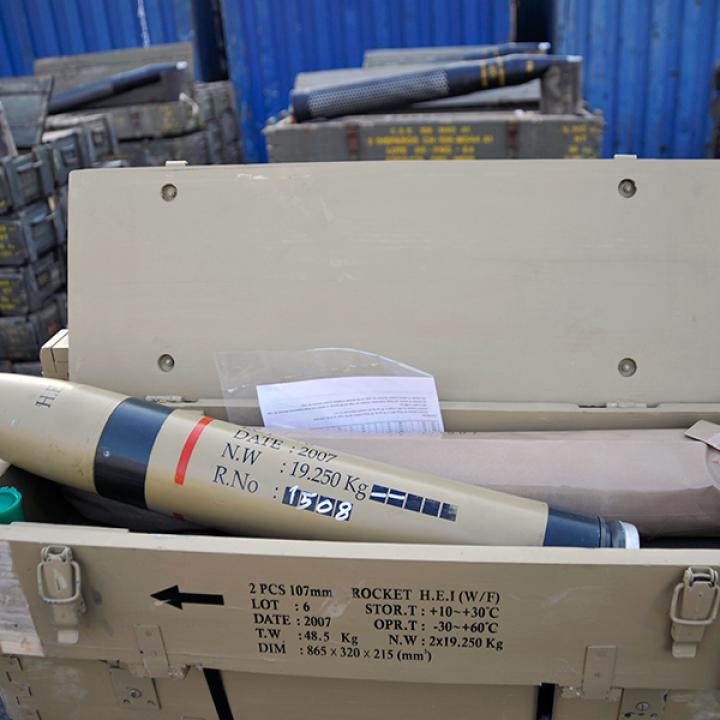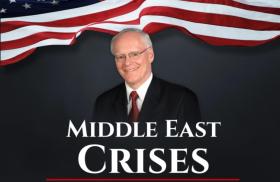
- Policy Analysis
- Articles & Op-Eds
Will Hezbollah Choose to Keep Its Word—or Its Arsenal?
Also published in Foreign Policy

The group must decide between walking back its threat to northern Israel or risking the loss of its advanced missile capabilities, which Iran regards as a crucial insurance policy.
In less than a week, Israel has managed to significantly degrade Hezbollah’s military capabilities, communications systems, and chain of command. First, exploding pagers and walkie-talkies undermined the group’s ability to communicate. Then came the assassination of operations commander Ibrahim Aqil on Friday—along with 14 top Radwan Force commanders—which was a major setback for the Lebanese militant group’s top leadership and command unit, the Jihad Council. From the founding members of Hezbollah’s military structure, only Ali Karaki survives today.
This escalation comes after Israeli leaders decided to confront the continuous threat to the country’s north posed by Hezbollah. Last Monday, Prime Minister Benjamin Netanyahu’s security cabinet decided to set a new war goal: the safe return of Israeli residents to the country’s north.
Hezbollah leader Hassan Nasrallah is not conceding, however. In a speech given on Sept. 19, Nasrallah doubled down on attacking Israel’s north. Despite his acknowledgement of Israel’s technological advances, the leader of Hezbollah refused to back down and threatened that “no military escalation, no killings, no assassinations, and no all-out war can return residents to the border.”
Immediately after his speech, Israel struck approximately 30 Hezbollah rocket launchers and infrastructure sites, which contained approximately 150 launcher barrels, according to a spokesperson from the Israel Defense Forces (IDF). The IDF also hit Hezbollah’s weapons storage facilities in multiple areas in southern Lebanon, followed by more intense strikes over the weekend, with Israel claiming on Saturday that it had eliminated 400 rocket launchers across southern Lebanon and the Beqaa Valley. The scale of these strikes indicates Israel’s appetite for escalation and willingness to widen the circle of targets.
Despite the calls to go all in, an Israeli decision to launch a full-scale war or land incursion has not been made yet. Such a decision would bring the country and its civilian infrastructure much damage, especially if Hezbollah unleashes its most advanced missiles. It seems that Israel is determined to push Hezbollah to change its strategy and revisit its involvement in the conflict, which the group initiated on Oct. 8, 2023, a day after the Hamas attacks on Israel. Hezbollah now faces a choice: to preserve what is left of its military assets and leadership, or to maintain its threat over the north of Israel.
The losses that Hezbollah suffered last week were immense, but the group lost the deterrence battle months ago. Since last October—when Hezbollah decided to attack Israel in support of Hamas—Israel has been successful at degrading the group’s military capabilities with precise targeted attacks, and it has done so largely without causing many civilian casualties. In the past year, Israel has killed more than 500 people—most of them Hezbollah militants— including top and elite commanders, such as Wissam al-Tawil, Taleb Abdullah, Fuad Shukr, and others.
In addition, Hezbollah’s military infrastructure south of the Litani River has been demolished, along with a large number of its weapons depots and military infrastructure across Lebanon. The group’s responses focused mostly on the north of Israel, targeting military bases and infrastructure while mostly avoiding civilian casualties, major cities, and civilian infrastructure.
At the beginning of the war, the goal of Hezbollah and Iran—the group’s main backer—was to reap the benefits from any political or diplomatic solution that would end the Israel-Hamas war in Gaza. But along the way, they managed to achieve an unprecedented feat—to move the buffer zone from the south of Lebanon to the north of Israel. Around 60,000 Israelis remain internally displaced, and Hezbollah has communicated this to its constituency as the biggest ever achievement against Israel. It will be very difficult to walk back from this.
If Israel widens the circle of targets to hit advanced military assets, such as the facilities that store and produce precision-guided missiles, Hezbollah might revisit its threat to the north. Today, the group is walking a very thin line between its assets and its threats, and the question is how many more losses it can endure.
Israel sees this as an opportunity to push further—and raise the price for Hezbollah until it becomes unbearable. Although a full-scale war between Israel and Hezbollah is a real possibility, both parties still prefer a diplomatic solution. Israel is trying to keep its attacks targeted, and Hezbollah is trying hard not to provoke Israel or be forced to use and waste its most valuable military assets—namely, precision missiles—which Iran regards as an insurance policy.
Indeed, Israel could be escalating today to avoid war; that is, to push Hezbollah to accept the only diplomatic solution on the table—the one presented by Amos Hochstein (the U.S. envoy for international energy affairs) to delink Lebanon from Gaza and implement U.N. Security Council Resolution 1701, which ended the 2006 war between Israel and Hezbollah. This means that Hezbollah will have to accept a separate cease-fire agreement, withdraw its military presence to north of the Litani River, roughly 18 miles away from the border, and allow displaced Israelis to return safely to the north.
Until last week, Israel and Hezbollah had been walking a very thin line between a full-scale war and a calculated pattern of attacks and responses. Hezbollah lost military infrastructure, commanders, and weapons, but most importantly, it lost security and trust among its ranks. After every assassination or strike, and specifically with the mass explosions of pagers and radios, Hezbollah now fears more in-depth infiltration in its ranks by the Israeli intelligence agencies. And its militants lost trust in their own, fearing that anyone could be an Israeli spy.
The group also lost trust in technology and has no reliable communications system that it could rely on for any military response or war. The only way left is verbal communications, which its leaders resorted to when the in-person meeting between Aqil and the Radwan Forces was scheduled—and then hit by an Israeli strike. The level of infiltration is deeper than they know.
Additionally, Hezbollah has lost the trust of its own community. If it cannot protect itself, many are asking, then how can it protect its constituency and supporters? It will be very difficult to assure its community of safety and security while walking—and exploding—among them. Worse still, the group is no longer Iran’s success story in the region.
The fact that Israel could kill Shukr and Aqil in the middle of their stronghold in the southern Beirut suburb of Dahiyeh is a big breach. However, what is a lot more troubling for Hezbollah’s leadership is its loss of the element of surprise, which has always been part of its military strategy. Israel knew exactly when and how Hezbollah was planning to retaliate for Shukr in August, as the IDF launched a preemptive strike against the group’s infrastructure, including the launchers it had prepared for the operation.
All these losses, in addition to the group’s incapacity thus far to conduct an effective military response against Israel, are both humiliating and embarrassing for Hezbollah. But on the military level, it is worse: Hezbollah is more deterred than ever.
The group could eventually recover from these losses, rebuild its communication network, counter Israeli intelligence, and regain trust among its community. But this is all going to take a long time, a luxury that Hezbollah might not be able to afford.
Today, any response to Israel’s escalation requires the militant group to resolve the following concerns. First, without a proper communications system, Hezbollah cannot coordinate on targeting, responses, or logistics. It also cannot easily use verbal or written communications—similar to the system that Hamas is currently using inside Gaza’s tunnels. Lebanon is much bigger, and without an efficient and fast communication system, Hezbollah’s military capability to conduct war is largely diminished.
Second, many top Hezbollah officials have been killed or injured. The pagers that exploded hit many of the group’s senior and mid-level operatives. The shipment contained 5,000 pagers, and Hezbollah’s fighting force alone has been independently estimated to comprise at least 20,000 militants. Pagers were provided to officials and fighters with special skills and missions; that is, those who need to be protected. Families of Hezbollah members of Lebanon’s parliament and high-ranking commanders, in addition to high-level security personnel, were among the casualties—not to mention Iran’s ambassador to Lebanon, who was reportedly in close proximity to an exploding device.
Finally, Hezbollah still hasn’t figured out how deeply infiltrated by Israeli intelligence it is. Sources close to its inner circle have told Foreign Policy that the group’s leaders are looking into every single piece of electronic gear they own, and that they are worried that their cars, motorcycles, and even their advanced missile factories are booby-trapped and could go off any minute.
The group will have to conduct an in-depth investigation to make sure that other items have not been infiltrated or compromised by the Israelis, which will take weeks. And if Hezbollah fears that its missile facilities are booby-trapped or monitored, it will be logistically very difficult to safely move these weapons in order to launch them.
The Israeli government seems to think that Hezbollah’s setbacks are a good opportunity for the IDF to launch a war to further erode the group’s capabilities. But a war similar to that of 2006 might cause Israel real damage without leading to the elimination of the Hezbollah threat. Moreover, it could lead to more international isolation and more civilian casualties on both sides, as well as risk a regional war from multiple fronts.
What the IDF and its external intelligence agency, Mossad, have achieved in the past week has been very effective. There is no need for a full-scale war that would cause civilian losses, bring back “axis of resistance” rhetoric, and unite regional and international public opinion against Israel.
Until a long-term solution is reached, the best-case scenario is for Hezbollah to accept a separate cease-fire, disconnected from the war in Gaza. Diplomatic messaging from the United States and its allies needs to focus on this objective and pressure Hezbollah to delink the two fronts. For Iran and Hezbollah, nothing is more important than their military assets—especially precision missiles.
U.S. diplomatic efforts need to take advantage of Hezbollah’s vulnerability. In addition to forcing the group to accept a separate cease-fire, negotiations should be focused on preventing a full-scale war, allowing residents from both sides to return home, and undermining Hezbollah’s and Iran’s narratives of victory and resistance.
U.N. Resolution 1701 is not sustainable because it does not include punitive measures, and Hezbollah will eventually violate it. Therefore, a long-term policy will have to be designed after a cease-fire is achieved in order to contain Hezbollah in Lebanon—a policy that will address interrupting its weapons supply routes from Tehran via Iraq and Syria as well as help the Lebanese state regain its sovereignty when it comes to decisions of war and peace.
Hanin Ghaddar is the Friedmann Senior Fellow at The Washington Institute and co-creator of its interactive map tracking clashes along the Israel-Lebanon border. This article was originally published on the Foreign Policy website.



